If you’re looking for help to identify large white birds, this will be the best article you read today.
In this post, you will find photos, identification info, size characteristics, and all the fun information you need.
Examples of large white birds include the great egret, wood stork, whooping crane, tundra swan, American white pelican, royal spoonbill, snowy owl, and many others.
The largest white bird in North America is the trumpeter swan which can reach a length of 6 ft, span over 10 ft across the wings, and weigh as much as 38 pounds.
The heaviest recorded water bird was a mute swan cob (male) from Poland that weighed stunning 51 pounds and was allegedly too heavy to take flight.
Here are the 25 most interesting ones.
Table of Contents
Large White Birds
Rock Ptarmigan
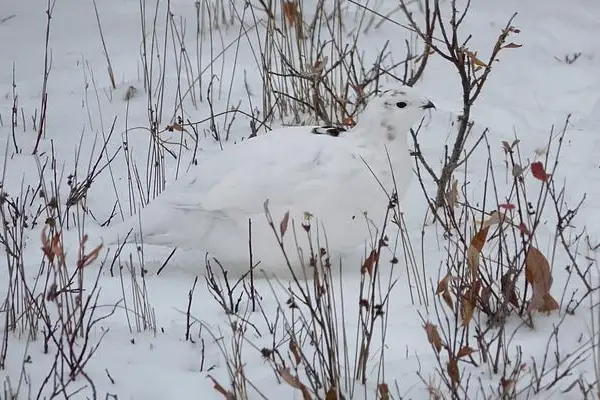
- Scientific Name: Lagopus muta
- Lifespan: up to 11 years
- Wingspan: 21–24 in
- Length: 13–14 in
- Weight: 1-1.4 lb
Rock ptarmigans are birds found in North America, Europe, and Asia.
These game birds come from the grouse family and have squared tails, small black beaks, and feathered legs and toes to walk in the snow and stay warm.
Breeding males have dark brown-gray upperparts and white underparts. When the winter comes, they become completely white to better blend with the environment.
Rock ptarmigans are common in northern parts of the USA; some populations can be seen in Washington during the non-breeding season.
Males are rather vocal and will emit different guttural snores and rattles, mostly when “fighting” other males during the breeding season. They will also make rasping “ah-AAH-ah” calls at females as part of their courting game.
Rock ptarmigans forage on the ground and are omnivores. They consume plant buds, leaves, flowers, small twigs, berries, and seeds, but also spiders, insects, and occasionally snails.
Rock ptarmigan breeding males have scarlet patches (“combs”) above their eyes that resemble eyebrows.
Read more about other birds that have such eyebrows here.
Great Egret
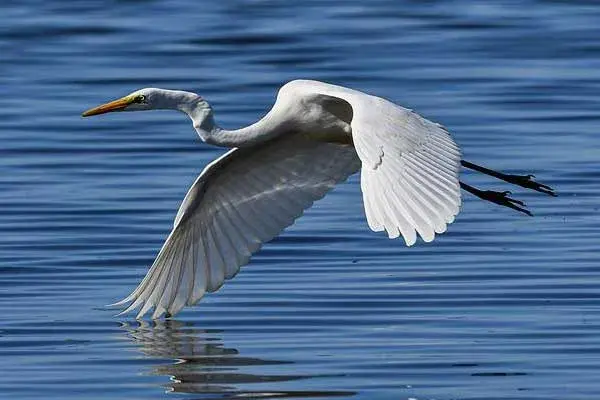
- Scientific Name: Ardea alba
- Lifespan: 22 years
- Wingspan: 52-67 in
- Length: 31-41 in
- Weight: 1.5-3.3 lb
Great egrets are impressively large birds with a wingspan of up to 5 ft 7 in and a weight of up to 3.3 lbs.
They are white and have long black legs and enormous yellow-orange beaks (4.2-5.3 inches long) that they use for hunting.
Great egrets are widespread throughout the world and can be seen in North, Central, South America, Europe, Asia, and Africa; usually around the tropical and warmer temperate regions.
In North America, great egrets almost become extinct in the 19th century as people were extensively hunting them for their beautiful plumes called “aigrettes” which were used as hat decoration.
Thanks to several laws and conservational measures, their numbers have since recovered.
Similar to pelicans because of their white plumage, great egrets can also tuck their necks right into their backs during flight.
They are seasonally monogamous (stay with the same partner for one breeding season) and breed in colonies in trees close to large lakes. To attract a female, a male great egret will display its mating season plumage and colors and point its beak upward.
Great egrets will slowly stalk their prey or stay motionless, waiting for the right moment to strike and impale prey with their long, sharp bills. They consume fish, frogs, small mammals, small reptiles, crustaceans, and insects.
They are also on our list of the biggest birds of PA.
Snowy Egret
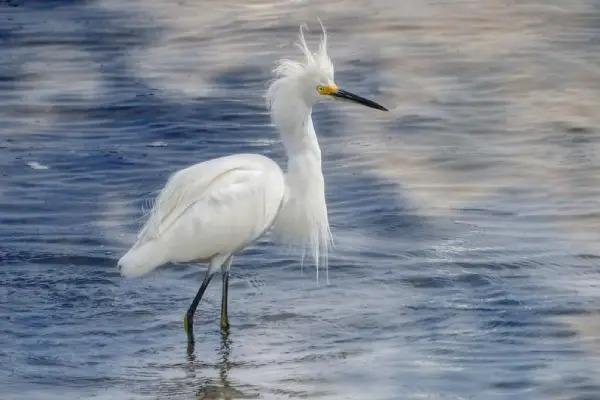
- Scientific Name: Egretta thula
- Lifespan: up to 17 years
- Wingspan: 39.4 in
- Length: 22-26 in
- Weight: 0.8 lb
Although smaller for an egret, snowy egrets are still rather large birds that can measure almost 3.3 ft across the wings.
They are completely white and have yellow lores (the region between the eyes and beaks), black legs, and bright yellow feet. Similar to great egrets, they also have shaggy aigrettes.
Snowy egrets are native to North, Central, and South America. In North America, they are permanent residents around the coastal parts of the Gulf of Mexico. They breed in south-central and northwestern parts of the USA.
Although quiet, snowy egrets will make several raspy or nasal calls, or snap their beaks during aggressive displays.
They mostly inhabit wetlands, including marshes, lakes, riverbanks, and pools; they avoid high altitudes and coasts.
Snowy egrets are social birds that can be seen breeding in mixed colonies together with great egrets, cattle egrets, glossy ibises, and other birds.
They are carnivores and have a diet consisting of fish, insects, small reptiles, crabs, shrimp, worms, etc.
Similar to other herons, snowy egrets also love to stalk their prey in shallow waters.
Read More: Ibis vs Egret – key differences and similarities
Wood Stork
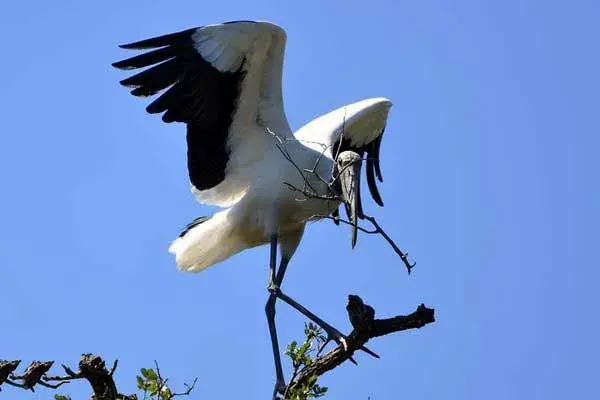
- Scientific Name: Mycteria americana
- Lifespan: up to 27 years
- Wingspan: 55–71 in
- Length: 33.5-45.3 in
- Weight: 4.4-7.3 lb
Wood storks are large North American wading birds and the only storks that breed in the United States.
They have a wingspan of almost 6 feet, can weigh up to 7.3 pounds (males), and can grow up to 3.75 ft tall.
They are easy to spot by their enormous size, white plumage with black edges on the back side of the wings, naked dark gray heads and necks, long legs, and long, slightly curved black beaks.
Wood storks are permanent residents of Central and Southern Florida and have small breeding populations in Georgia, and North and South Carolina.
They are common around freshwater marshes, lakes, ponds, and canals.
Wood storks are listed as threatened in the US. After three-decade-long conservation and recovery efforts, the species moved from endangered to threatened species in June 2014.
They are very social birds that feed in flocks and nest in large rookeries – sometimes with several pairs on a single tree.
They build large stick nests in the trees, the female will lay two to five eggs, and both of the parents will take turns incubating them for about one month. To keep their nestlings cool, wood storks will regurgitate water over them.
Among other states, wood storks are native to Florida. Check the other Florida natives here.
Cattle Egret

- Scientific Name: Bubulcus ibis
- Lifespan: 16-23 years
- Wingspan: 34.6-37.7 in
- Length: 18-22 in
- Weight: 0.6-1.12 lb
Cattle egrets are stocky egrets that measure up to 1 ft 10 inches in length, span up to 3.15 ft across the wings, and can weigh over a pound.
These large white birds got their name from the habit of following cattle and other large animals. Cattle egrets can be identified by their white plumage, short legs, thick necks, and dull orange beaks and legs.
When the breeding season comes, they might develop some orange patches on their backs, breasts, and heads.
They were introduced to North America around the 1940s and expanded so much that they reached as far west as California.
In Hawaii, these birds were introduced in 1959. They went from 105 released birds to over 30,000 by 1981.
- Read More: List of white birds found in Hawaii
They are mostly quiet but will make weak and throaty “rick-rack” calls at their breeding colonies.
In North America, cattle egrets breed from April to October and nest in large colonies around water, woodlands near lakes or rivers, swamps, small inland islands, etc.
Look for their perfect “V” formation as they fly in flocks.
They feed on land insects, worms, frogs, lizards, and small mammals.
Snowy Owl
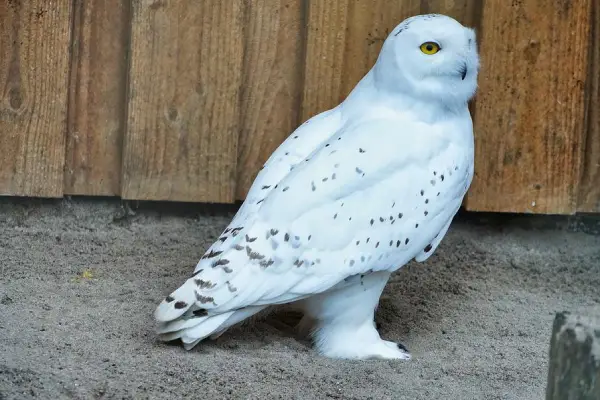
- Scientific Name: Bubo scandiacus
- Lifespan: 10 years in the wild
- Wingspan: 45.7-72 in
- Length: 21-28 in
- Weight: 2.9-6.5 lb
Snowy owls are enormous white birds. They are the heaviest owls in North America and have a longer wingspan than any other owl found there.
Because of the cold Arctic weather, snowy owls need good insulation; even their feet are covered with feathers!
This resulted in them being one of the heaviest owls in the world.
Females are larger than males and can weigh as much as 6.5 pounds and span up to 6 feet across the wings.
They are the only white owls in the world and males tend to be whiter than females; both have some black or brown markings on the body and wings and yellow eyes.
Snowy owls are native to the Arctic region of North America and breed on the tundra.
They are very vocal birds with over 15 different calls. The most common call consists of 2-6 rough notes that sound like “krooh-krooh” and can be heard for miles. They might also make some rattle “rick-rick-ha-how-quock” calls.
Snowy owls are diurnal birds that sleep during the night and hunt during the day, especially when the summer comes; their diet includes small mammals, some water birds, fish, and even carrion.
Their favorite food is lemmings (small mouselike rodents) – they might hunt as much as 1,600 of those per year.
Snowy owls are monogamous and mate for life. A female will lay 3-11 eggs in the nest on the ground. The male will feed her while she incubates the eggs for around a month.
Read More: More examples of white-colored raptors
Whooping Crane
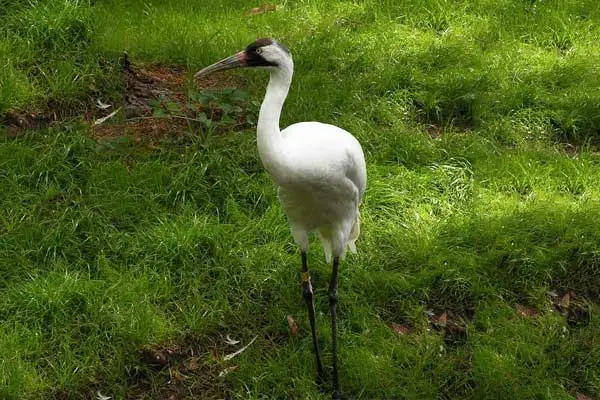
- Scientific Name: Grus americana
- Lifespan: 22-24 years
- Wingspan: 79-90 in
- Length: 52 in
- Weight: 9.9-18.7 lb
Named after the whooping sounds they make, whooping cranes are the tallest North American birds that can stand over 5 ft in height.
Together with sandhill cranes, they are the only two crane species native to North America and can reach 7 ft 7 in across the wings.
They have snowy white colors, crimson caps, black wings seen during flight, and very long, dark, and pointed beaks they use to probe the ground with.
In the USA, whooping cranes breed in central Wisconsin and Texas; there are also reintroduced non-migratory populations in Florida and Louisiana.
They are common around wetland areas, where they feed on crabs, clams, frogs, and aquatic plants.
Whooping cranes are known for their “unison calls” while courting and their loud bugle calls that last less than a second when they feel alarmed.
This endangered crane species had a population of just 20 birds in the 1940s. In recent years, thanks to strong conservation efforts, the total number of whooping cranes has now exceeded 800 birds.
They breed from April to May and have a clutch size of 1-3 olive-colored eggs. Both parents will incubate the eggs.
Whooping cranes have many predators, including black bears, wolves, foxes, coyotes, and eagles.
Wandering Albatross
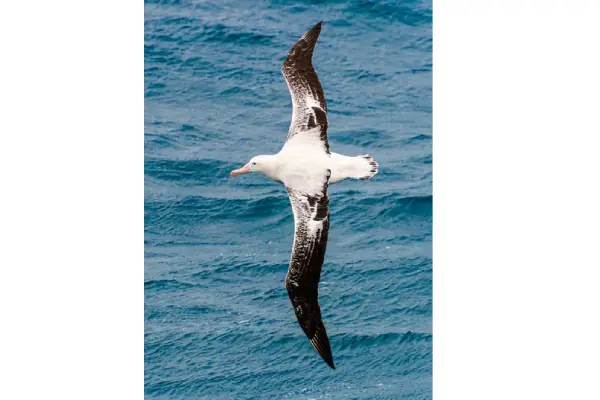
- Scientific Name: Diomedea exulans
- Lifespan: over 60 years
- Wingspan: 98.8-137.8 in
- Length: 42-53 in
- Weight: 13-28 lb
Wandering albatrosses are huge white birds with the longest wingspan of any living bird; they can span up to 11 ft 6 in across the wings!
Some claimed even bigger examples, with two gigantic birds supposedly having wingspans of 13 ft 10 in and even 17 ft 5 in, but they weren’t verified.
Adults are white with black and white wings; males have whiter wings than females. These albatrosses also have the whitest plumage of all wandering albatross species.
Wandering albatrosses are found across the Southern Ocean, including the Antarctic, sub-Antarctic and subtropical waters.
They are birds with some of the longest migrations that can cover over 75,000 miles in a year.
They are also very vocal and will make different screams, whistles, grunts, and beak claps.
Wandering albatrosses are monogamous, mate for life, and breed on subantarctic islands around early February.
They are carnivores and feed on fish, cephalopods, jellyfish, crustaceans, and penguin and seal carrion.
Royal Spoonbill

- Scientific Name: Platalea regia
- Lifespan: 15+ years
- Wingspan: 47 in
- Length: 29–32 in
- Weight: 3.1–4.6 lb
Royal spoonbills, also known as black-billed spoonbills, are large and conspicuous birds found in Australia, New Zealand, Indonesia, Papua New Guinea, and the Solomon Islands.
These white birds have long, spoon-shaped bills, and black legs. They use their long legs to wad through wetlands and sweep through the water with their long beaks to catch fish, shellfish, crabs, and amphibians.
When they get into breeding season, royal spoonbills develop long white plumes on their heads.
Royal spoonbills build their nests from sticks in trees; females lay 2-3 eggs.
American White Ibis

- Scientific Name: Eudocimus albus
- Lifespan: 16 years in the wild
- Wingspan: 35-41 in
- Length: 21-28 in
- Weight: 1.3-2.7 lb
American white ibises are large wetland birds with all-white plumage and black wing tips seen during flight.
They also have very long legs, pink facial skins, and long necks held straight in flight. Their bright red-orange downcurved beaks become pink with black tips during the breeding season.
Males tend to be bigger than females and have longer beaks.
In the USA, American white ibises are permanent residents in states along the Gulf and the Atlantic coast, including Florida, Texas, Louisiana, the Carolinas, and Virginia.
They inhabit shallow coastal marshes, wetlands, mangrove swamps, and even parks and golf courses.
American white ibises make several sounds, including the honking “urnk-urnk” call they use in flight or when agitated, and the muted “huu-huu” call when foraging.
They are very social birds with some colonies including over 30,000 birds.
They breed during spring and summer, females lay between two and four eggs, and both parents take turns in incubating the eggs.
One field study in Florida discovered that white ibises spent around 10 hours a day looking for food, less than an hour flying, and 13 hours resting and roosting.
They are carnivores and consume crabs, crayfish, fish, snakes, frogs, and insects that they find by probing the ground with their long beaks.
White ibises are protected by the U.S. Migratory Bird Treaty Act – it is illegal to hunt them.
Read More: 25+ examples of Florida’s native birds
Glaucous Gull
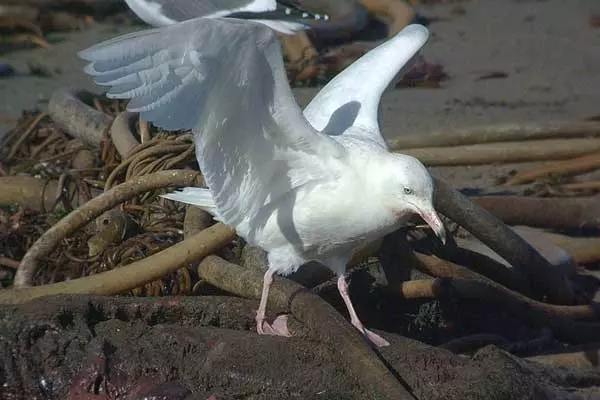
- Scientific Name: Larus hyperboreus
- Lifespan: 15-20 years
- Wingspan: 52-67 in
- Length: 22-30 in
- Weight: 3-3.4 lb
Glaucous gulls are large white birds and the second largest gulls in the world.
They have deep chests, heavy beaks, and large heads that make their eyes appear small.
You will recognize them by their white-gray colors, yellow beaks, and pink legs.
In the USA, glaucous gulls winter around the northeastern Atlantic states (from Maine to North Carolina) and the northwestern Pacific states (Oregon and Washington). Some populations might occasionally move south and reach Florida, Texas, or northwestern Mexico.
Glaucous gulls have a deep “laughing” cry call that resembles one of the herring gulls.
They are omnivores that feed on almost anything, from fish, insects, and mollusks, to small birds, small mammals, carrion, and plants.
Glaucous gulls breed in colonies around coasts and cliffs; females will lay 2-4 light brown eggs with dark brown spots.
Black-winged Kite

- Scientific Name: Elanus caeruleus
- Lifespan: up to 6 years
- Wingspan: 31.5-37.4 in
- Length: 13.8-15 in
- Weight: 0.43-0.75 lb
Black-winged kites are large white birds with dark shoulder patches, wing tips, and eye stripes. They also have forward-facing red eyes and long falcon-like wings that sit beyond the tails when perched.
Black-winged kites inhabit open savannahs, semi-deserts, and agricultural lands with scattered woods of sub-Saharan Africa, South Asia, and Europe.
Males are territorial and protect their areas from competition.
These large birds are noisy during courtship and the females are the ones that do most of the nest building. They will lay a clutch of 3-4 creamy eggs with red spots that both parents incubate.
Black-winged kites are carnivores and have a diet consisting of insects (grasshoppers, crickets), lizards, rodents, small snakes, frogs, and some birds.
Tundra Swan
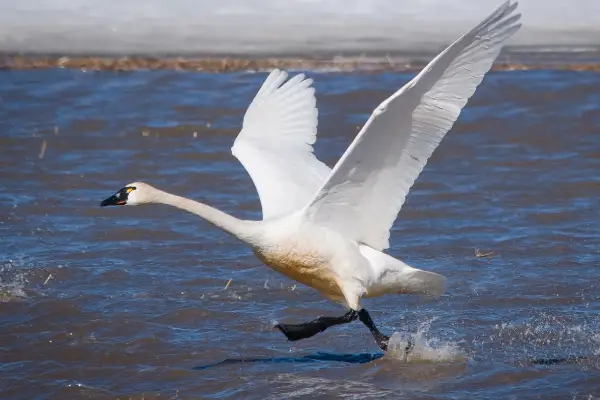
- Scientific Name: Cygnus columbianus
- Lifespan: 10 years
- Wingspan: 66-83 in
- Length: 45–59 in
- Weight: 7.5–21.2 lb
Tundra swans are large white birds with long necks, black beaks and legs, dark eyes, and yellow “teardrops” in front of the eyes. Males and females look alike.
Tundra swans, as the name suggests, breed in the tundra of the Arctic and subarctic and can be found around shallow pools, lakes, and rivers.
Around September, they will migrate to winter grounds on the Pacific coast (from Vancouver Island to Northern California and from southern Idaho to southern Colorado river) and around the eastern Great Lakes and the mid-Atlantic coast.
Tundra swans are the most numerous of the North American swans and are nicknamed “whistling” because of the sound their wing flapping produces.
Source: U.S. Fish and Wildlife Service, Public domain, via Wikimedia Commons
They become very aggressive and territorial during the breeding season; in other parts of the year, tundra swans are rather social birds.
They are monogamous, mate for life, and build nests near lakes and other open waters that both parents construct. The female will incubate 4-5 eggs while the male helps; both parents will raise the young.
Tundra swans are omnivores and mainly feed on aquatic plants and roots, some arthropods, worms, and shellfish.
Mute Swan

- Scientific Name: Cygnus olor
- Lifespan: up to 10 years in the wild
- Wingspan: 79-94 in
- Length: 49-67 in
- Weight: 18.7-32 lb
Mute swans are large swan species that were introduced to North America in the late 19th century.
They were named “mute” for being less vocal than other swan species, but still produce a variety of hisses, bugles, and other sounds.
They measure up to 5 ft 7 in long, span 7 ft 10 in across the wings, and weigh up to 32 pounds. Identify mute swans by their all-white plumage, orange beaks with black borders, and pronounced knobs on top of their beaks.
Mute swans are common around wetland areas including marshes, lakes, parks, and ponds in the northeastern USA.
These aggressive, territorial, and invasive swans will fight with the native trumpeter swans on Lake Erie marshes and other locations, pushing them out of their nesting area.
Due to their large numbers and negative effect on other waterfowl and vegetation, they are considered invasive species.
Mute swans are omnivores that feed on aquatic vegetation, aquatic insects, fish, and frogs.
Whooper Swan
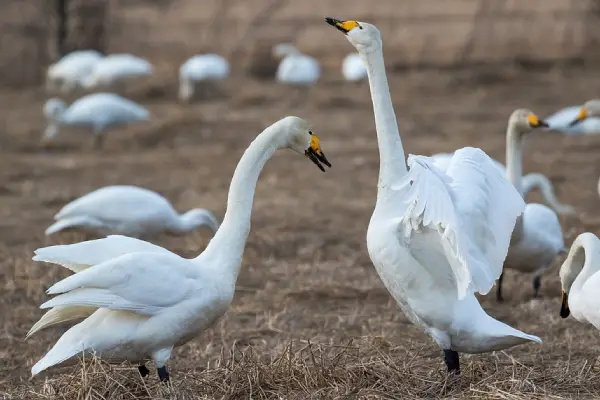
- Scientific Name: Cygnus cygnus
- Lifespan: up to 26 years
- Wingspan: 81–108 in
- Length: 55–65 in
- Weight: 16.3-30.8 lb
Whooper swans, also known as common swans, are large birds of the northern hemisphere.
They are the European counterparts of the North American trumpeter swans and can have a wingspan of up to 8 feet.
Scientists consider them among the heaviest flying birds and recorded a male in Denmark that weighed 34.17 pounds.
They have pure white plumage, black webbed feet and legs, and orange-yellow beaks with black tips.
Whooper swans are commonly found in Europe and Asia, around large areas of water, preferably wetlands.
They are vocal birds with deep honking calls, similar to those of trumpeter swans.
They are monogamous and mate for life; females will lay 4-7 eggs.
Whooper swans forage in shallow waters and have a diet consisting of aquatic plants and roots; their young will eat small insects and different invertebrates to get the required protein needed for their proper growth.
Whooper swans are the national birds of Finland and are featured on their 1 euro coins.
White Cockatoo

- Scientific Name: Cacatua alba
- Lifespan: 40–60 years in captivity
- Wingspan: 35 in
- Length: 18 in
- Weight: 0.9-1.7 lb
White cockatoos are also known as umbrella cockatoos.
These large white birds are endemic to the tropical rainforests of Indonesia.
They have mostly white plumage with some yellow or pink feathers on the undersides of their wings and tails. On top of their heads, there are large crests that resemble umbrellas these birds extend when surprised (hence the nickname).
They also have dark eyes and dark gray beaks.
White cockatoos nest in cavities of large trees. Their courtship behavior includes feather ruffling, tail spreading, wing extending, and crest erection.
After pairing, partners will preen each other’s heads and scratch around the tails as this strengthens their bond. They will have a clutch of 2 white eggs that both parents incubate.
White cockatoos are omnivores that feed on seeds, berries, nuts, fruits, insects, insect larvae, and even some small lizards.
Due to habitat loss and illegal bird trade, white cockatoos have declined in the wild and are listed as Endangered by the International Union for Conservation of Nature (IUCN).
Because of their close bonds with their owners and affectionate nature, people want to keep them as pets.
White cockatoos are very intelligent, easy to train, and can imitate basic human speech.
Snow Goose
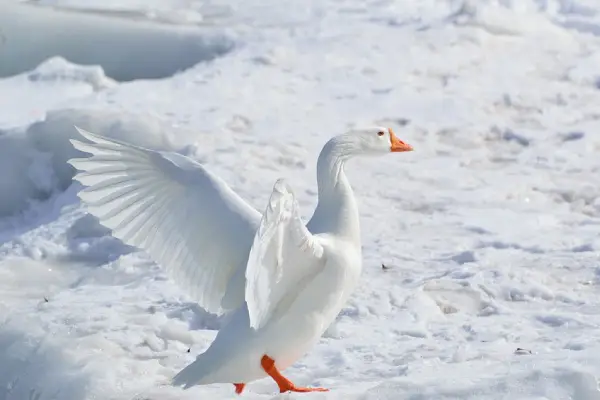
- Scientific Name: Anser caerulescens
- Lifespan: 15-25 years
- Wingspan: 53-65 in
- Length: 25-31 in
- Weight: 4.5-9.9 lb
Snow geese are a large goose species native to North America.
There are two morphs, white and dark.
The white morph, as the name suggests, has snow-white plumage, black wing tips, rose red feet, and pink beaks.
Snow geese breed in Greenland, Alaska, and Canada from late May to mid-August.
They migrate to their warmer wintering grounds mainly in the Southern and Central USA and are common around grasslands and agricultural fields. Some populations winter on the Atlantic coast.
Snow geese are very vocal species and their most common call is a nasal, one-syllable honk.
These big white birds nest in colonies, females select nesting places and build them on high ground (Star Wars alert), and lay 3-5 creamy-white eggs.
Snow geese are herbivores that feed on seeds, grasses, leaves, and roots.
There are 2 subspecies, the lesser snow goose which is smaller and winters in southern parts of the USA, and the greater snow goose which winters in northeastern parts of the USA.
Sandwich Tern
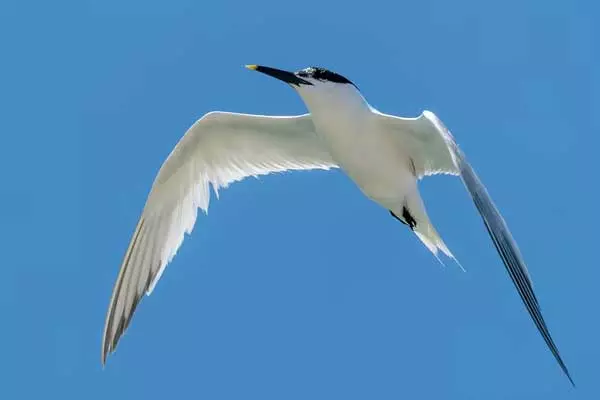
- Scientific Name: Thalasseus sandvicensis
- Lifespan: 18-22 years
- Wingspan: 33-38 in
- Length: 15-17 in
- Weight: 0.4-0.66 lb
Sandwich terns are large birds with white underparts, pale gray upperparts, black crests, and yellow-tipped black beaks. Identify them by their long, pointed wings and medium-long tails that are deeply split.
- Read More: More examples of birds with split tails
Sandwich terns are commonly found in Europe, Asia, Africa, and South America. In North America, they are common around the Gulf Coast and the Atlantic coast (mainly around Florida).
They are very vocal birds that make loud “kear-ik” calls.
Sandwich terns got their peculiar name from the town Sandwich in the United Kingdom, where the ornithologist who first described the bird in 1787 just happened to live.
Sandwich terns are carnivores that mostly consume smaller fish, shrimp, squid, marine worms, and many insects.
They feed by plunge-diving into the water for fish and then offering it to the female as part of the courtship display.
Masked Booby
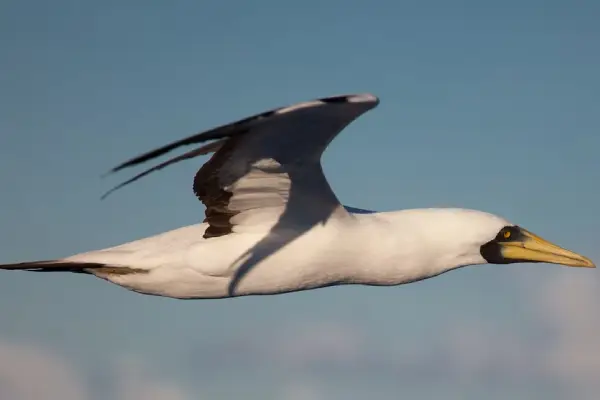
- Scientific Name: Sula dactylatra
- Lifespan: n/a
- Wingspan: 63-67 in
- Length: 30-33 in
- Weight: 2.6-4.9 lb
The masked booby, also known as the masked gannet, is a large seabird with a long neck and wings, a pointed tail, and a large beak.
Adults are bright white and have black wings, facial masks, and tails.
With a length of up to 2 ft 9 in, they are the largest booby species in the world.
The masked booby breeds in the Caribbean, across the Pacific Ocean, to Hawaii, Australia, and Indonesia.
It is a social bird that breeds in colonies found on remote islands, atolls, and cays.
Although quiet at sea, masked booby gets very vocal around nesting grounds. The main call males make is a descending whistle; females make loud honks.
The masked booby is a carnivore and its diet mainly consists of fish, but also some squid.
The name “booby” comes from the Spanish word “bobo” meaning fool, most likely due to their “clumsy” courtship dances.
These big white birds nest in shallow holes in the ground, lay 1-2 eggs, and decorate their nests.
One study found a large masked booby nest with 988 pieces of small stone or coral, 155 fragments of shell, 10 pieces of avian skeletal material, and one small piece of wood!
Yellow-billed Stork
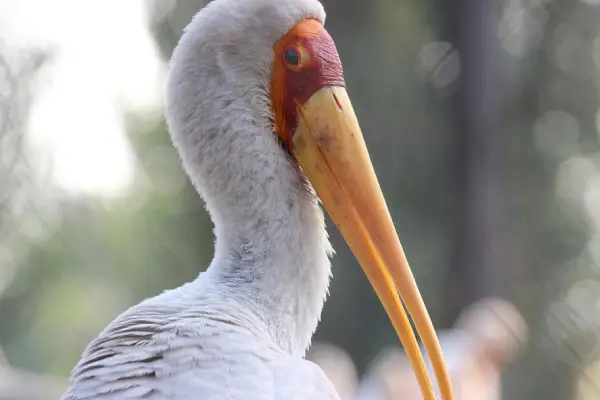
- Scientific Name: Mycteria ibis
- Lifespan: 19 years in captivity
- Wingspan: 59-65 in
- Length: 35–41 in
- Weight: 4.2-5.1 lb
Yellow-billed storks are enormous African wading storks that can weigh over 5 pounds and stand 3 feet 5 inches tall.
They have white bodies and short black tails. Their beaks are deep yellow and slightly curved; they also have bright red facial skin patches, long necks and beaks with very quick muscle reflexes that allow them to swiftly catch their prey in water.
Yellow-billed storks are widespread south of the Sahara region of Africa and in Madagascar and inhabit wetlands, shallow waters, lakes, swamps, and lagoons.
They are carnivores that feed on small fish, worms, frogs, small mammals, birds, aquatic insects, and crustaceans.
They hunt using their sense of touch, by stirring and probing water to find their next meal. As they get in contact with the prey, they quickly snap their mandibles, raise their heads, and swallow the prey alive.
Despite not being a particularly social species, yellow-billed storks might gather in groups when there’s lots of food available.
Dalmatian Pelican
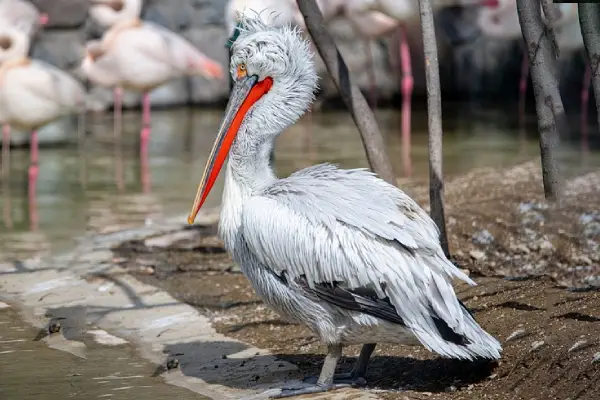
- Scientific Name: Pelecanus crispus
- Lifespan: 35 years
- Wingspan: 96.4-142.1 in
- Length: 63-72 in
- Weight: 16.0-33.1 lb
Dalmatian pelicans are the largest species of pelican and one of the largest freshwater birds in the world.
They can measure up to 6 ft long, weigh up to 33 pounds, and span up to 11 ft 6 in across the wings.
They have silvery-white plumage, gray legs, and the second-longest beaks in the world (up to 18 in).
Dalmatian pelicans are native to Europe and Asia and inhabit lakes, rivers, deltas, and estuaries.
They are mainly quiet, similar to other pelicans. However, when the breeding season comes, these large white birds will make various deep sounds, including barks, hisses, and grunts.
They are carnivores (piscivores) and almost completely feed on fish.
Dalmatian pelicans need around 2.6 pounds of fish per day to survive.
These large white birds will use their long beaks and pouches to swoop fish and water, dump the water on the side of their pouches, and swallow the prey.
Dalmatian pelicans might also eat some worms, beetles, water birds, and crustaceans.
They nest in small groups, build their nests on or near the ground, and have a clutch of 1-6 whitish eggs that both parents incubate.
Their numbers have been declining and some estimates claim a total population of 10,000-20,000 birds today.
American White Pelican

- Scientific Name: Pelecanus erythrorhynchos
- Lifespan: 16-30 years
- Wingspan: 95-120 in
- Length: 50–70 in
- Weight: 11-20 lb
American white pelicans are one of the largest white birds in North America.
Everything about these white birds with black flight feathers is enormous. They have a wingspan of up to 9.85 feet and can weigh as much as 30 pounds.
American white pelicans also have the longest beaks of any North American waterbirds. Their beaks are vivid yellow-orange and measure 11.3–15.2 inches in males and 10.3–14.2 inches in females.
American white pelicans breed in interior North America and Canada. When the winter comes, they move to winter on the Pacific and Gulf of Mexico coasts, from central California and Florida south to Panama.
Their diet mostly consists of fish, but also some crayfish and salamanders.
A group of pelicans is called a “brief” and a “squadron”.
Read More: Other birds with long bills found in Florida
Australian Pelican
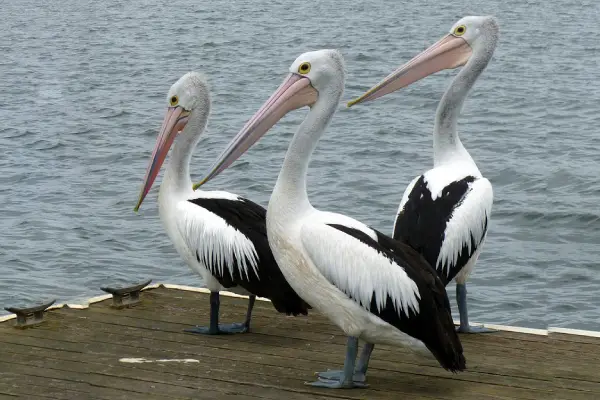
- Scientific Name: Pelecanus conspicillatus
- Lifespan: 10-25 in the wild
- Wingspan: 90.5-102.3 in
- Length: 60–74 in
- Weight: 8.8-28.7 lb
Australian pelicans are enormous waterbirds found in inland and coastal waters of Australia, New Guinea, Fiji, and parts of Indonesia.
They have white plumage with black wings, pink beaks, and very long and thick necks held back during flight.
Australian pelicans have the longest beaks of any living bird; their beaks can measure up to 20 inches in length!
Their main habitats include large lakes, rivers, swamps, estuaries, coastal lagoons, etc.
Australian pelicans are carnivores that mainly feed on fish, crustaceans, turtles, and tadpoles; they will also harass and rob other birds of their prey.
They hunt using their sensitive beaks and beak pouches that serve as a fishing net and can hold almost 3.5 gallons of water.
These white birds with long necks breed colonially and can have over 40,000 individuals on a single island.
After a successful courtship ritual, females will dig the scrape in the ground and line it with available vegetation and feathers.
Both parents incubate the clutch of 1-3 eggs, and the first young that hatches will be larger than its siblings and might even attack or kill them.
Trumpeter Swan
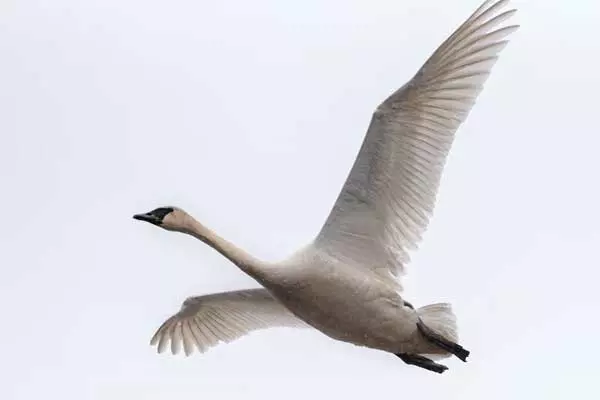
- Scientific Name: Cygnus buccinator
- Lifespan: up to 25 years
- Wingspan: 72.8-98 in
- Length: 54-70.8 in
- Weight: 21-28 lb
Trumpeter swans are one of the largest species of waterfowl in the world. They are also both the heaviest and longest native birds of North America.
The largest known trumpeter swan measured 6 ft long, had a wingspan of 10 ft 2 in, and weighed impressive 38 lbs.
They can be identified by their enormous size, white colors, pinkish legs, and black bills up to 4.7 inches long.
Trumpeter swans breed in large shallow ponds, undisturbed lakes, wetlands, wide slow rivers, and marshes of northwestern and central North America and Alaska.
They migrate to spend winter around the Pacific coast of Northwestern USA and Canada.
Trumpeter swans are loud birds and their calls sound similar to a trumpet, which resulted in the specie’s name.
They are omnivores and eat plants found in or near the water. Their diet might also include some insects, small fish, and eggs, but trumpet swans prefer plants overall.
They had a population of around 3,700 birds in 1968 and thanks to strong conservatory measures and efforts, scientists recorded over 63,000 of these large white birds back in 2015.
They can be seen in Ohio, and are just one of many examples of birds found in the northeastern parts of the state.
Great White Pelican

- Scientific Name: Pelecanus onocrotalus
- Lifespan: over 16 years
- Wingspan: 89-141.7 in
- Length: 55-71 in
- Weight: 20-33 lb
Great white pelicans are enormous birds, only slightly smaller than Dalmatian pelicans.
They are also known as eastern white pelicans or rosy pelicans and can measure 5.9 feet in length and weigh up to 33 pounds.
Great white pelicans also have dull pale yellow gular pouches and huge pink and yellow beaks that can measure up to 18.5 inches long.
They are predominantly white with black flight feathers and yellowish bases on their necks.
Great white pelicans breed in southeastern Europe, Asia, and Africa, around swamps and shallow lakes. Their breeding season starts around April and a female will lay 1-4 eggs that both parents raise.
Read More: List of big African birds
Highly social birds, great white pelicans will often form large flocks.
They are carnivores that mainly feed on fish and need to consume 2-3 pounds per day.
Although adults are protected from other birds of prey due to their size, their eggs, nestlings, and fledglings can be in danger. Occasionally, jackals, lions, or crocodiles might hunt these large pelicans.
Want to see what their white opposites look like? Check our list of small white-colored birds with photos.
Summary
This concludes our list of large white birds.
Examples include several types of swans, pelicans, gulls, kites, geese, storks, and egrets.
Next time, should you see these birds in person, you should be able to recognize any of them with ease!
And if you enjoyed our article, here are our other popular reads on birds: List of common birds seen in Northern Georgia